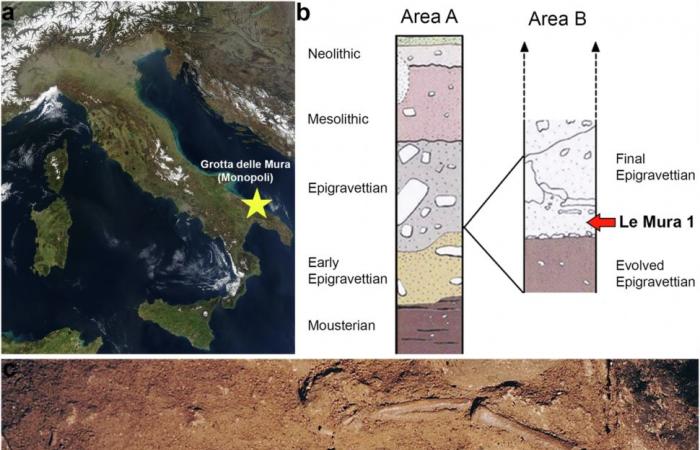Discovered under two massive stones, the perfectly preserved skeleton of a child aged around a year and a half intrigues researchers. The temperate region of southern Italy offered humans a rare climatic refuge 17,000 years ago.
b) Complete stratigraphy and cultural sequence of the site, with location of the child in the stratigraphy.
c) Photograph of the child during the search (photo by Mauro Calattini).
Scientific examinations revealed that the child had gone through serious health challenges. His teeth show signs of deficiency, suggesting a short life marked by illness and poor nutrition. Analysis reveals that the mother, probably in poor health, had remained in the region. In this nomadic population, this sedentary lifestyle could be linked to mobility constraints or to pregnancy difficult. A striking element in the DNA analyzes was also noted, concerning mutations in two essential genes, which can cause hypertrophic cardiomyopathy. This pathology alters the thickness of the walls of the heart, limiting its effectiveness.
These complications could have affected the child from birth and even before. This discovery sheds light on the living conditions and hardships of the first inhabitants of Europe. This baby belonged to a group of hunter-gatherers called Villabruna, characteristic of the glacial peoples of Italy. These communities were small, favoring inbreeding ; his parents were probably first cousins.
This burial testifies to the care that the elders gave to their deceased, even the youngest. This gesture highlights the complexity of their social structure and their funeral practices.
What is the Villabruna group?
The Villabruna group designates an ancient population of hunter-gatherers who lived in the sud of Europe after the last glaciationbetween 19,000 and 14,000 BCE. Discovered in the Italian region of Villabruna, these individuals revealed distinct genetic traits, mixing European and Asian origins.
DNA analyzes show that the Villabruna group marked a new lineage in Europe, with significant genetic influence on modern European populations. This group exhibits adaptations to postglacial conditions and genetics that show resilience in extreme environments, likely through small, isolated communities.
Health






